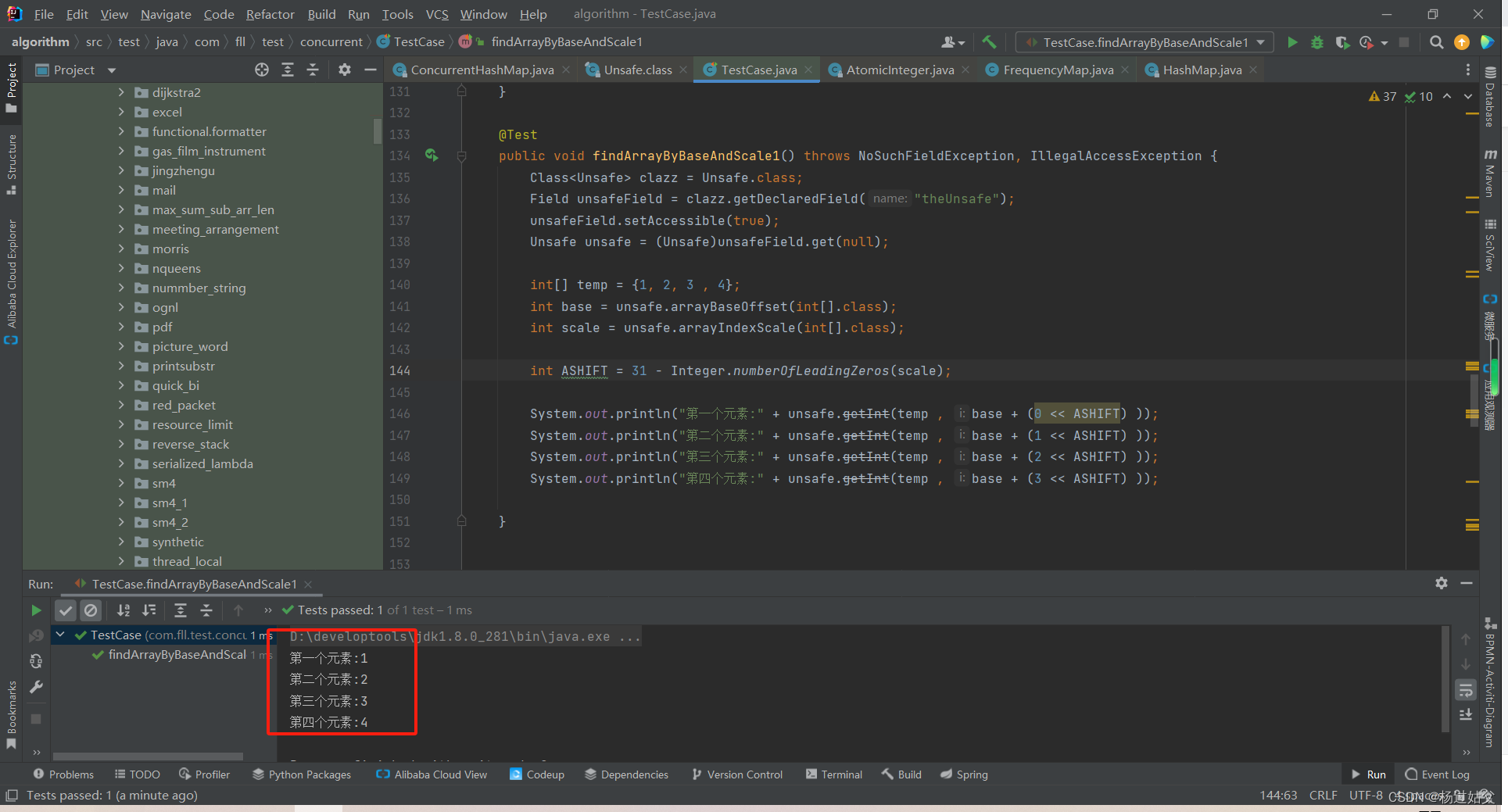一、实验内容
用一个真双端RAM,端口A和端口B同时向RAM里写入数据0-99,A端口读出单数并存入单端口RAM1中,B端口读出双数并存入但端口RAM2中,当检测到按键1到来时将RAM1中的单数读出显示到PC端,当检测到按键2到来时,将RAM2中的双数显示到pc端。
二、信号流向图
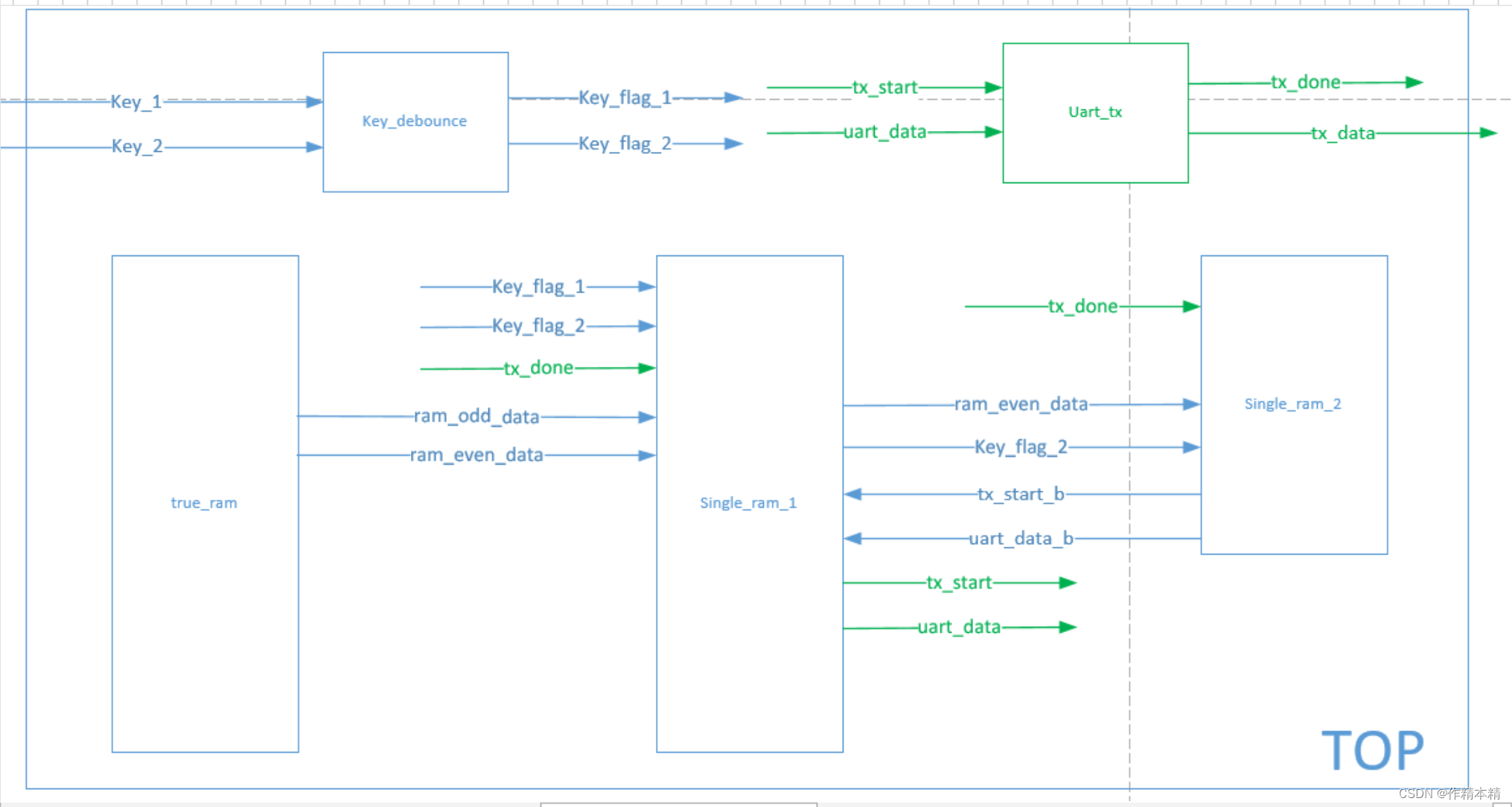
TIPS:这里我本来想将single_ram_1和single_ram_2分成两个单独的模块,但是经过实验后发现,如果分成两个单独的模块的话会导致:
①两个单端RAM模块的tx_start(0或1)都会有值给uart_tx模块,即使是RAM1给【1】,RAM2中没有值【0】,uart_tx模块是无法判断 tx_start 到底来自于哪个模块,所以此时uart_tx模块只是能接收到一个tx_start的脉冲信号,但是无法判断信号来自哪个RAM模块,无法获取到相应的uart_data ,最终导致tx_flag都无法变成高电平,那就更不会返回给RAM模块tx_done信号了。
②如果单独为了正确信号能赋值给tx_start而重新去写一个ctrl模块的话,那么在ctrl模块中将无法使用判断条件,因为我们将状态作为了赋值条件而不仅仅是key_flag信号。
那么我的解决方法就是把single_ram_2例化到single_ram_1当中,将single_ram_2输出的数据(uart_data_b及tx_start_b)和single_ram_1输出的数据(douta即tx_start_a)全部放在一个模块即single_ram_1中去做判断,但是我们仍然无法将single_ram_2的状态作为赋值的条件,所以只能采用这种比较粗暴的方式,也就是除了( cur_state == REG || cur_state == READ )时候tx_start <= tx_start_a ;那么其他情况就是tx_start <= tx_start_b ; uart_data的处理也是同样。详见后面程序。
其实最好的方式是将single_ram_2和single_ram_1写在同一个模块中,程序放在文章最后了。
三、程序设计
(1)按键消抖模块:
这里注意key1和key2不能使用同一个计数器,不然在同一个模块中也会判断出问题。
`timescale 1ns / 1ps
module key_debounce(
input sys_clk ,
input rst_n ,
input key1 ,
input key2 ,
output key_flag_1 ,
output key_flag_2
);
// parameter delay = 100_000_0 ; //20ms
parameter delay = 100;// 测试用
reg[19:0] cnt1 ;
reg[19:0] cnt2 ;
key_flag_1
always@(posedge sys_clk )
if(!rst_n)
cnt1 <= 0 ;
else if ( key1 == 0 )begin
if ( cnt1 == delay -1 )
cnt1 <= cnt1 ;
else
cnt1 <= cnt1 +1 ;
end
else
cnt1 <= 0 ;
assign key_flag_1 = ( cnt1 == delay -2 )?1:0 ;
///key_flag_2
always@(posedge sys_clk )
if(!rst_n)
cnt2 <= 0 ;
else if ( key2 == 0 )begin
if ( cnt2 == delay -1 )
cnt2 <= cnt2 ;
else
cnt2 <= cnt2 +1 ;
end
else
cnt2 <= 0 ;
assign key_flag_2 = ( cnt2 == delay -2 )?1:0 ;
endmodule
(2)真双端模块:
IP参数:
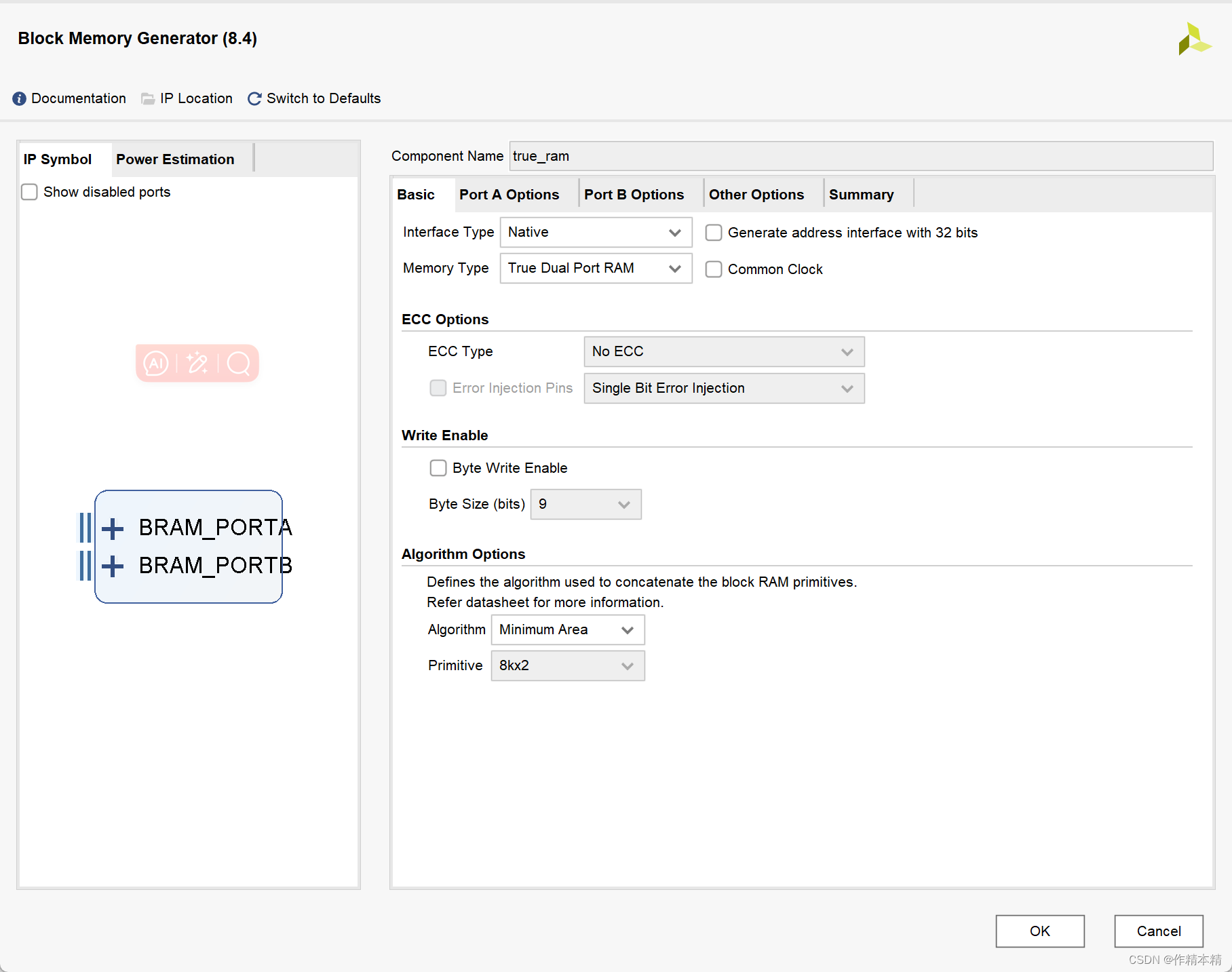
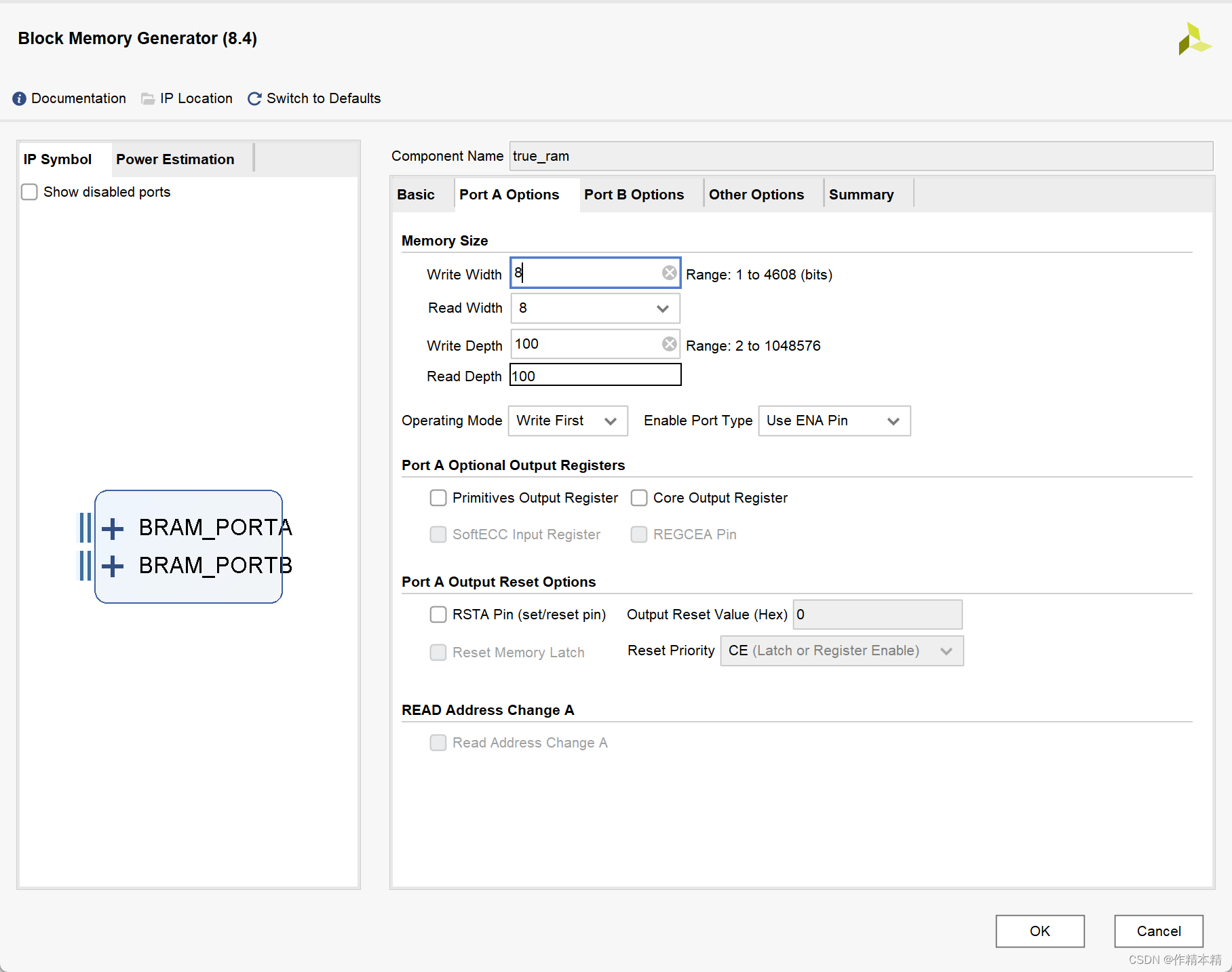
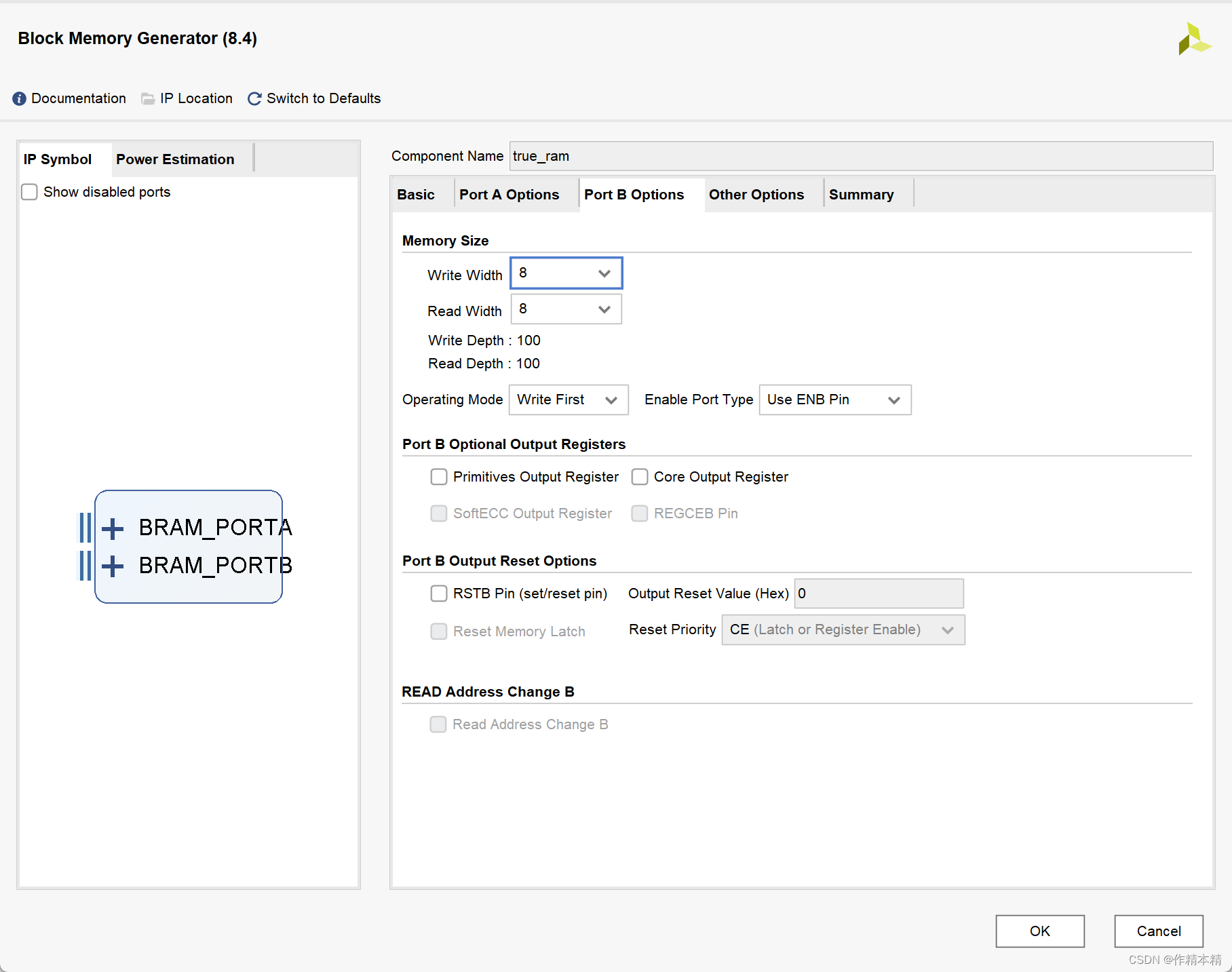
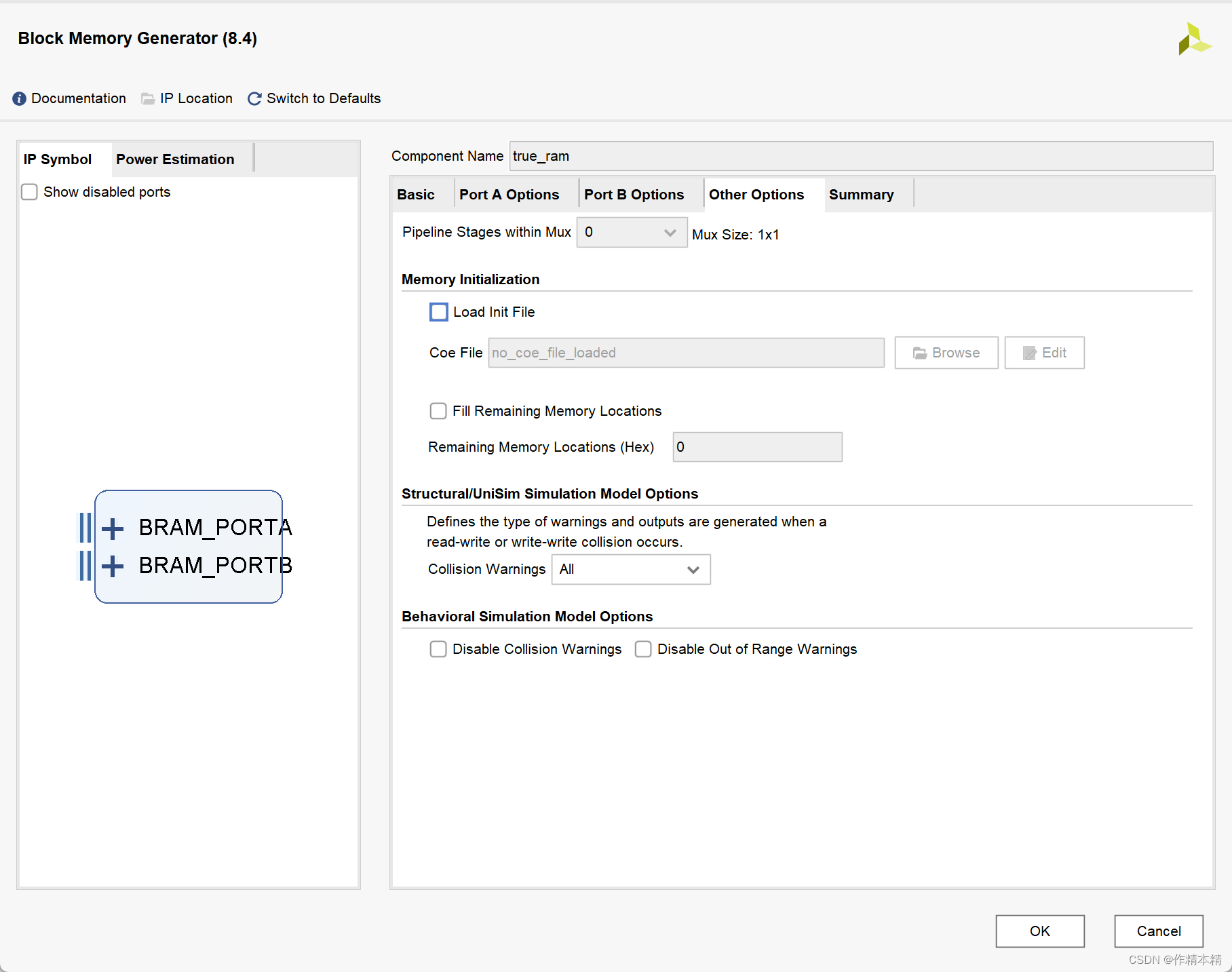
`timescale 1ns / 1ps
module the_true_ram(
input sys_clk ,
input rst_n ,
output [7:0] ram_odd_data ,
output [7:0] ram_even_data
);
A端口
reg wea ;
reg [6 : 0] addra ;
reg [7 : 0] dina ;
wire [7 : 0] douta ;
always@(posedge sys_clk )
if(!rst_n)
wea <= 0 ;
else if ( addra >= 99 )
wea <= 0 ;
else
wea <= 1 ;
always@(posedge sys_clk )
if(!rst_n)
addra <= 0 ;
else if ( addra >= 99 )
addra <= 99 ;
else
addra <= addra +1 ;
always@(posedge sys_clk )
if(!rst_n)
dina <= 0 ;
else if (dina >= 99)
dina <= 99 ;
else
dina <= dina +1 ;
wire [7:0] data_a ;
assign data_a = douta ;
assign ram_odd_data = (data_a%2 == 1)?data_a : ram_odd_data ;
///b端口
reg web ;
reg [6 : 0] addrb ;
reg [7 : 0] dinb ;
wire [7 : 0] doutb ;
always@(posedge sys_clk )
if(!rst_n)
web <= 0 ;
else if ( addrb >= 99 )
web <= 0 ;
else
web <= 1 ;
always@(posedge sys_clk )
if(!rst_n)
addrb <= 0 ;
else if ( addrb >= 99 )
addrb <= 99 ;
else
addrb <= addrb +1 ;
always@(posedge sys_clk )
if(!rst_n)
dinb <= 0 ;
else if ( dinb >= 99 )
dinb <= 99 ;
else
dinb <= dinb +1 ;
wire[7:0] data_b ;
assign data_b = doutb ;
assign ram_even_data = (data_b %2 == 0 )? data_b : ram_even_data ;
//----------- Begin Cut here for INSTANTIATION Template ---// INST_TAG
true_ram your_instance_name (
.clka(sys_clk ), // input wire clka
.ena(1), // input wire ena
.wea(wea), // input wire [0 : 0] wea
.addra(addra), // input wire [6 : 0] addra
.dina(dina), // input wire [7 : 0] dina
.douta(douta), // output wire [7 : 0] douta
.clkb(sys_clk ), // input wire clkb
.enb(1), // input wire enb
.web(web), // input wire [0 : 0] web
.addrb(addrb), // input wire [6 : 0] addrb
.dinb(dinb), // input wire [7 : 0] dinb
.doutb(doutb) // output wire [7 : 0] doutb
);
// INST_TAG_END ------ End INSTANTIATION Template ---------
endmodule
(3)单端RAM2模块:
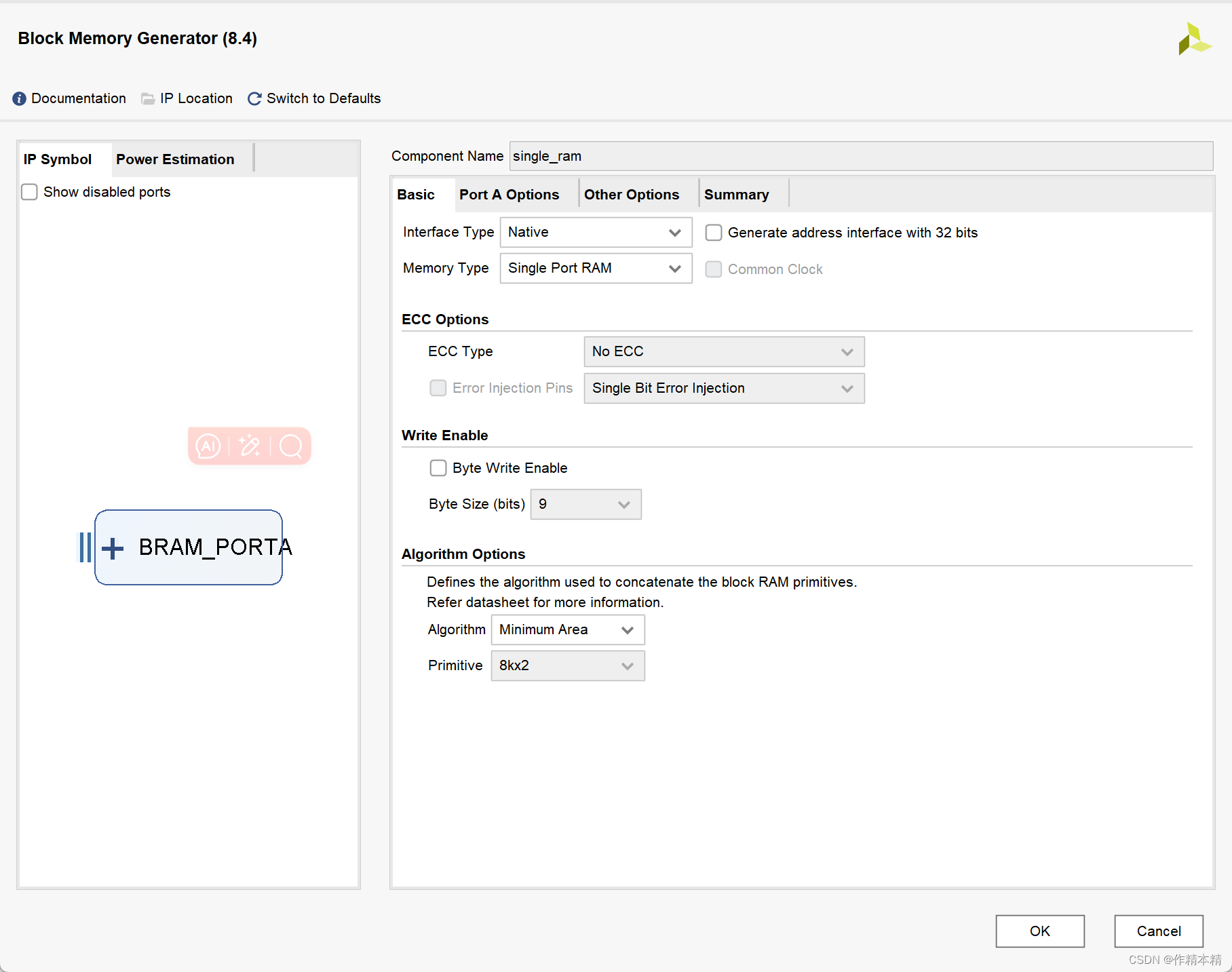

但其实深度在50就够用了。(100里面的奇数和偶数50)
`timescale 1ns / 1ps
module single_ram_2_FMS(
input sys_clk ,
input rst_n ,
input key_flag_2 ,
input tx_done ,
input [7:0] ram_even_data ,
output reg tx_start_b ,
output reg[7:0] uart_data_b
);
存双数的RAM
reg ena ;
reg [0 : 0] wea ;
reg [6 : 0] addra ;
reg [7 : 0] dina ;
wire [7 : 0] douta ;
//先写再读出
localparam IDLE = 3'd0 ;
localparam WRITE = 3'd1 ;
localparam REG = 3'd2 ;
localparam READ = 3'd3 ;
reg[2:0] cur_state ;
reg[2:0] next_state ;
//state1
always@(posedge sys_clk )
if(!rst_n)
cur_state <= IDLE ;
else
cur_state <= next_state ;
//state2
always@(*)
case(cur_state)
IDLE :
begin
next_state = WRITE ;
end
WRITE :
begin
if ( key_flag_2 )
next_state = REG ;
else
next_state = cur_state ;
end
REG :
begin
next_state = READ ;
end
READ :
begin
if(addra == 49)
next_state = IDLE ;
else
next_state <= cur_state ;
end
default:;
endcase
//state3
always@(posedge sys_clk )
if(!rst_n)begin
ena <= 0 ;
wea <= 0 ;
addra <= 0 ;
dina <= 0 ;
tx_start_b <= 0 ;
end
else
case(cur_state)
IDLE :
begin
ena <= 0 ;
wea <= 0 ;
addra <= 0 ;
dina <= ram_even_data ;
end
WRITE :
begin
ena <= 1 ;
wea <= 1 ;
if(addra == 49)
addra <= 49 ;
else
addra <= addra +1 ;
dina <= ram_even_data ;
end
REG :
begin
addra <= 0 ;
ena <= 0 ;
wea <= 0 ;
dina <= 0 ;
tx_start_b <= 1 ;
end
READ :
begin
ena <= 1 ;
wea <= 0 ;
dina<= 0 ;
if(tx_done)begin
tx_start_b <= 1 ;
addra <= addra +1 ;
end
else begin
tx_start_b <= 0 ;
addra <= addra ;
end
end
default:;
endcase
//----------- Begin Cut here for INSTANTIATION Template ---// INST_TAG
single_ram ram2 (
.clka(sys_clk ), // input wire clka
.ena(ena), // input wire ena
.wea(wea), // input wire [0 : 0] wea
.addra(addra), // input wire [6 : 0] addra
.dina(dina), // input wire [7 : 0] dina
.douta(douta) // output wire [7 : 0] douta
);
// INST_TAG_END ------ End INSTANTIATION Template ---------
always@(posedge sys_clk )
if(!rst_n)
uart_data_b <= 0 ;
else if ( cur_state == READ )
uart_data_b <= douta ;
else
uart_data_b <= uart_data_b ;
always@(posedge sys_clk )
if(!rst_n)
tx_start_b <= 0 ;
else if ( cur_state == REG || cur_state == READ )
tx_start_b <= 1 ;
else
tx_start_b <= tx_start_b ;
endmodule
(4)单端RAM1模块
配置和前面一样
`timescale 1ns / 1ps
module single_ram_1_FMS(
input sys_clk ,
input rst_n ,
input key_flag_1 ,
input key_flag_2 ,
input tx_done ,
input[7:0] ram_odd_data ,
input[7:0] ram_even_data,
output reg tx_start ,
output reg[7:0] uart_data
);
/读单数的RAM
reg ena ;
reg wea ;
reg [6 : 0] addra ;
reg [7 : 0] dina ;
wire [7 : 0] douta ;
reg tx_start_a ;
wire tx_start_b ;
wire[7:0] uart_data_b ;
先写再读出
localparam IDLE = 3'd0 ;
localparam ERITE = 3'd1 ;
localparam REG = 3'd2 ;
localparam READ = 3'd3 ;
reg[2:0] cur_state ;
reg[2:0] next_state ;
//state1
always@(posedge sys_clk )
if(!rst_n)
cur_state <= IDLE ;
else
cur_state <= next_state ;
//state2
always@(*)
case(cur_state)
IDLE :
begin
next_state = ERITE ;
end
ERITE :
begin
if(key_flag_1)
next_state = REG ;
else
next_state <= cur_state ;
end
REG :
begin
next_state = READ ;//用来发送tx_start
end
READ :
begin
if(addra == 49)//100内的单数是50
next_state = IDLE ;
else
next_state = cur_state ;
end
default:;
endcase
//state3
always@(posedge sys_clk )
if(!rst_n)begin
ena <= 0 ;
wea <= 0 ;
addra<= 127 ;
dina <= 0 ;
tx_start_a <= 0 ;
end
else
case(cur_state)
IDLE :
begin
ena <= 0 ;
wea <= 0 ;
addra<= 7'd127 ;
dina <= ram_odd_data ;
end
ERITE :
begin
ena <= ~ena ;
wea <= ~wea ;
if( addra == 49 && wea)
addra <= 49 ;
else if(wea)
addra <= addra +1 ;
dina <= ram_odd_data ;
end
REG :
begin
ena <= 0 ;
wea <= 0 ;
addra<= 0 ;
dina <= 0 ;
tx_start_a <= 1 ;
end
READ :
begin
ena <= 1 ;
wea <= 0 ;
dina<= 0 ;
if(tx_done)begin
tx_start_a <= 1 ;
addra <= addra +1 ;
end
else begin
tx_start_a <= 0 ;
addra <= addra ;
end
end
default:;
endcase
//----------- Begin Cut here for INSTANTIATION Template ---// INST_TAG
single_ram ram1 (
.clka(sys_clk ), // input wire clka
.ena(ena), // input wire ena
.wea(wea), // input wire [0 : 0] wea
.addra(addra), // input wire [6 : 0] addra
.dina(dina), // input wire [7 : 0] dina
.douta(douta) // output wire [7 : 0] douta
);
// INST_TAG_END ------ End INSTANTIATION Template ---------
always@(posedge sys_clk )
if(!rst_n)
uart_data <= 0;
else if ( cur_state == READ )
uart_data <= douta ;
else
uart_data <= uart_data_b ;
always@(posedge sys_clk )
if(!rst_n)
tx_start <= 0 ;
else if ( cur_state == REG || cur_state == READ )
tx_start <= tx_start_a ;
else
tx_start <= tx_start_b ;
例化ram2
single_ram_2_FMS single_ram_2_FMS_u(
. sys_clk (sys_clk ) ,
. rst_n (rst_n ) ,
. key_flag_2 (key_flag_2 ) ,
. tx_done (tx_done ) ,
. ram_even_data (ram_even_data) ,
. tx_start_b (tx_start_b ) ,
. uart_data_b (uart_data_b )
);
endmodule
(5)uart_tx模块:
`timescale 1ns / 1ps
module uart_tx(
input sys_clk ,
input rst_n ,
input wire[7:0] uart_data ,
input rx_done ,
output reg tx_data ,
output reg tx_done
);
parameter SYSCLK = 50_000_000 ;
parameter Baud = 115200 ;
parameter COUNT = SYSCLK/Baud ;//434 传输1比特所需要的时钟周期
parameter MID = COUNT/2 ;
wire start_flag ;
reg tx_flag ;
reg tx_reg1 ;
reg tx_reg2 ;
reg[4:0] cnt_bit ;
reg[10:0] cnt ;
//tx_start
always@(posedge sys_clk)
if(!rst_n)begin
tx_reg1 <= 0 ;
tx_reg2 <= 0 ;
end
else begin
tx_reg1 <= rx_done ;
tx_reg2 <= tx_reg1 ;
end
assign start_flag = tx_reg1 & ~tx_reg2 ;
///tx_flag
always@(posedge sys_clk)
if(!rst_n)
tx_flag <= 0 ;
else if ( start_flag == 1 )
tx_flag <= 1 ;
else if ( cnt == COUNT -1 && cnt_bit == 10)
// else if ( cnt == MID -1 && cnt_bit == 10)
tx_flag <= 0 ;
else
tx_flag <= tx_flag ;
///计时器
// cnt 434
always@(posedge sys_clk )
if(!rst_n)
cnt <= 0;
else if ( tx_flag == 1 )begin
if ( cnt == COUNT -1) ///一定要减一,如果不减一,实际会计到435次,反算回去波特率就不是115200了
cnt <= 0;
else
cnt <= cnt +1 ;
end
else
cnt <= 0 ;
// /计数器
always@(posedge sys_clk )
if(!rst_n)
cnt_bit <= 0 ;
else if ( tx_flag )begin
if ( cnt == COUNT -1)begin
if(cnt_bit == 10)///0123456789 10
cnt_bit <= 0 ;
else
cnt_bit <= cnt_bit +1 ;
end
else
cnt_bit <= cnt_bit ;
end
else
cnt_bit <= 0 ;
parameter MODE_CHECK = 0 ;
always@(posedge sys_clk )
if(!rst_n)
tx_data <= 1 ; //表示没有数据
else if ( tx_flag )begin
if ( cnt_bit > 0 && cnt_bit < 9 )
///cnt_bit 0 12345678 9
///tx_data 0123456789
///uart_data 01234567
tx_data <= uart_data [cnt_bit-1]; //这里uart_data是不断随着cnt_bit变化的,只有在第九位的时候才有正确的最终值
else if(cnt_bit == 0)
tx_data <= 0 ;
else if(cnt_bit == 9)
tx_data <= (MODE_CHECK == 0)? ^uart_data: ~^uart_data;
/*
MODE_CHECK == 0是偶校验,假如uart_data是1110_0000,其异或的结果
是1,将异或的结果作为校验位,让数据位和校验位异或的结果为0,满足偶校验。
假如uart_data是1110_1000,其异或的结果是0,将异或的结果作为校验位,
让数据位和校验位异或的结果为0,满足偶校验。奇校验则相反。
*/
else if (cnt_bit == 10)///停止位
tx_data <= 1 ;
else
tx_data <= tx_data ;
end
else
tx_data <= 1 ;
always@(posedge sys_clk )
if(!rst_n)
tx_done <= 0 ;
else if (tx_flag)begin
if ( cnt_bit == 10 && cnt == COUNT -1)
// if ( cnt_bit == 10 && cnt == MID/2 -1)
tx_done <= 1 ;
else
tx_done <= 0 ;
end
else
tx_done <= 0 ;
endmodule四、仿真模块
(1)仿真true_ram模块
代码:
`timescale 1ns / 1ps
module test_the_true_ram( );
reg sys_clk ;
reg rst_n ;
wire [7:0] ram_odd_data ;
wire [7:0] ram_even_data ;
initial
begin
sys_clk = 0 ;
rst_n = 0 ;
#10
rst_n = 1 ;
end
always #1 sys_clk = ~sys_clk ;
the_true_ram the_true_ram_1(
. sys_clk (sys_clk ) ,
. rst_n (rst_n ) ,
. ram_odd_data (ram_odd_data ) ,
. ram_even_data (ram_even_data)
);
endmodule
仿真结果:
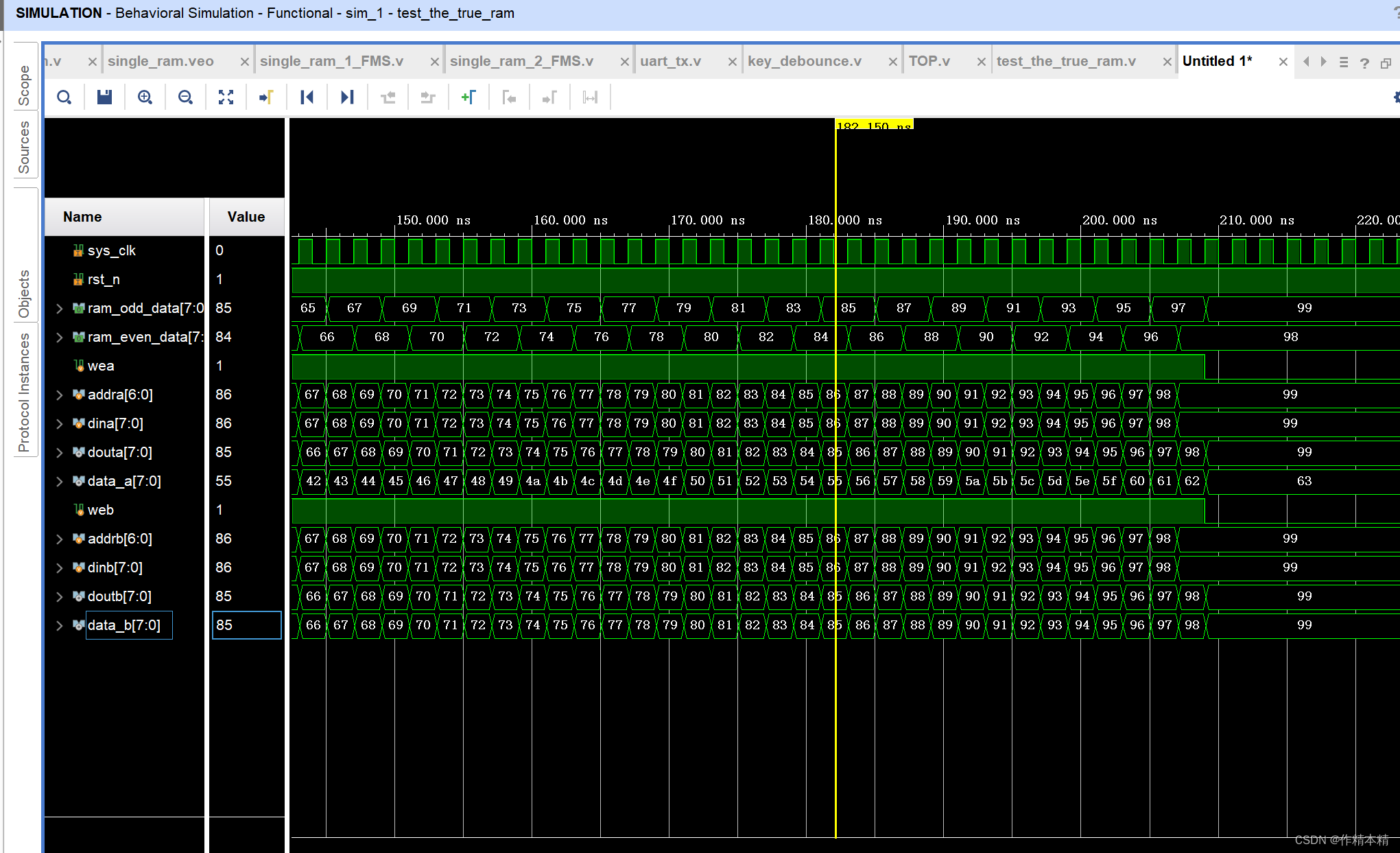
(2)仿真TOP:
代码:
`timescale 1ns / 1ps
module test_TOP( );
reg sys_clk ;
reg rst_n ;
reg key_1 ;
reg key_2 ;
wire tx_data ;
initial
begin
sys_clk = 0 ;
rst_n = 0 ;
key_1 = 1 ;
key_2 = 1 ;
#10
rst_n = 1 ;
#10000
key_1 = 0 ;
end
always #1 sys_clk = ~sys_clk ;
TOP TOP_1(
. sys_clk (sys_clk) ,
. rst_n (rst_n ) ,
. key_1 (key_1 ) ,
. key_2 (key_2 ) ,
. tx_data (tx_data)
);
endmodule
仿真结果:
TOP:
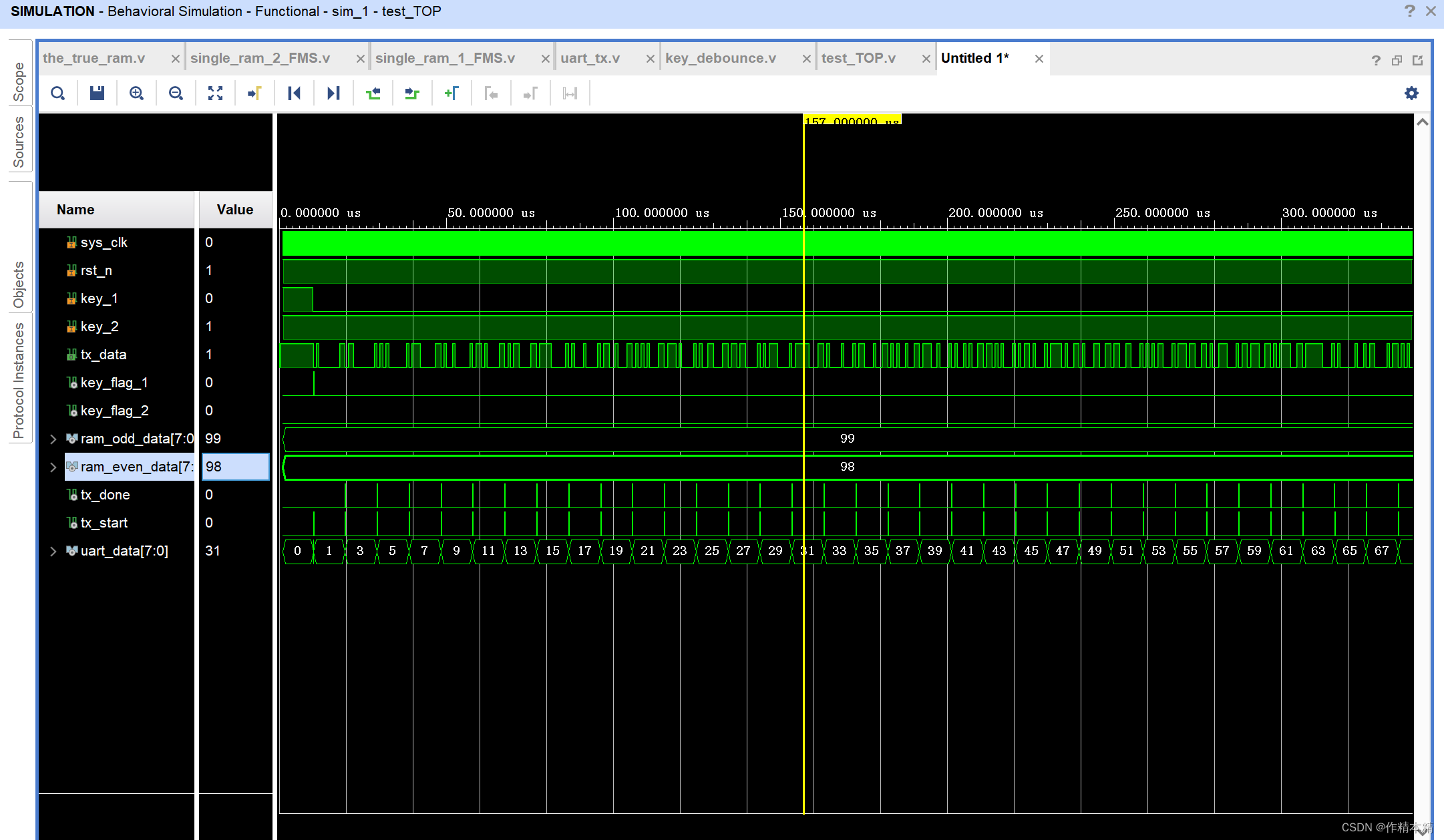
single_ram_1 :
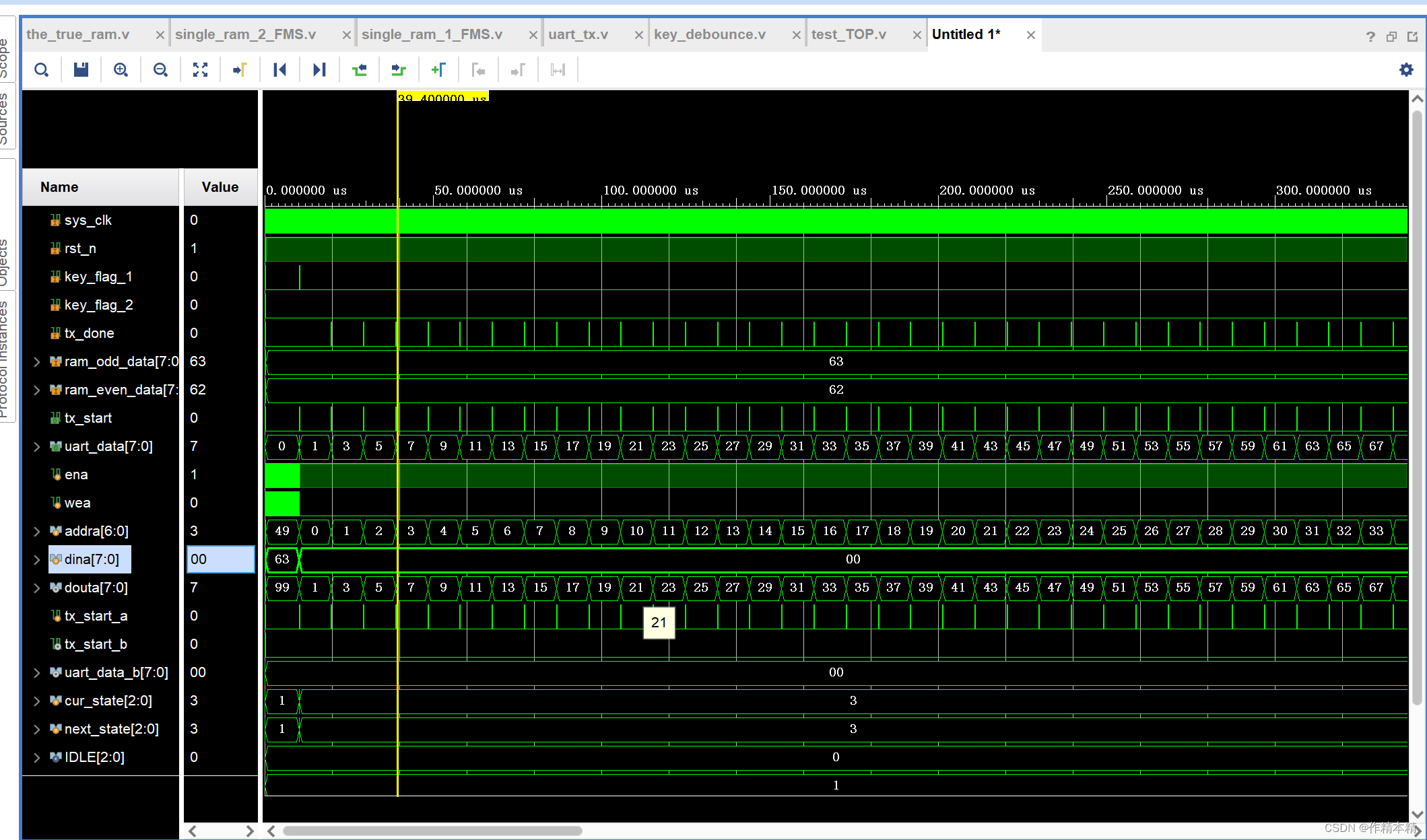
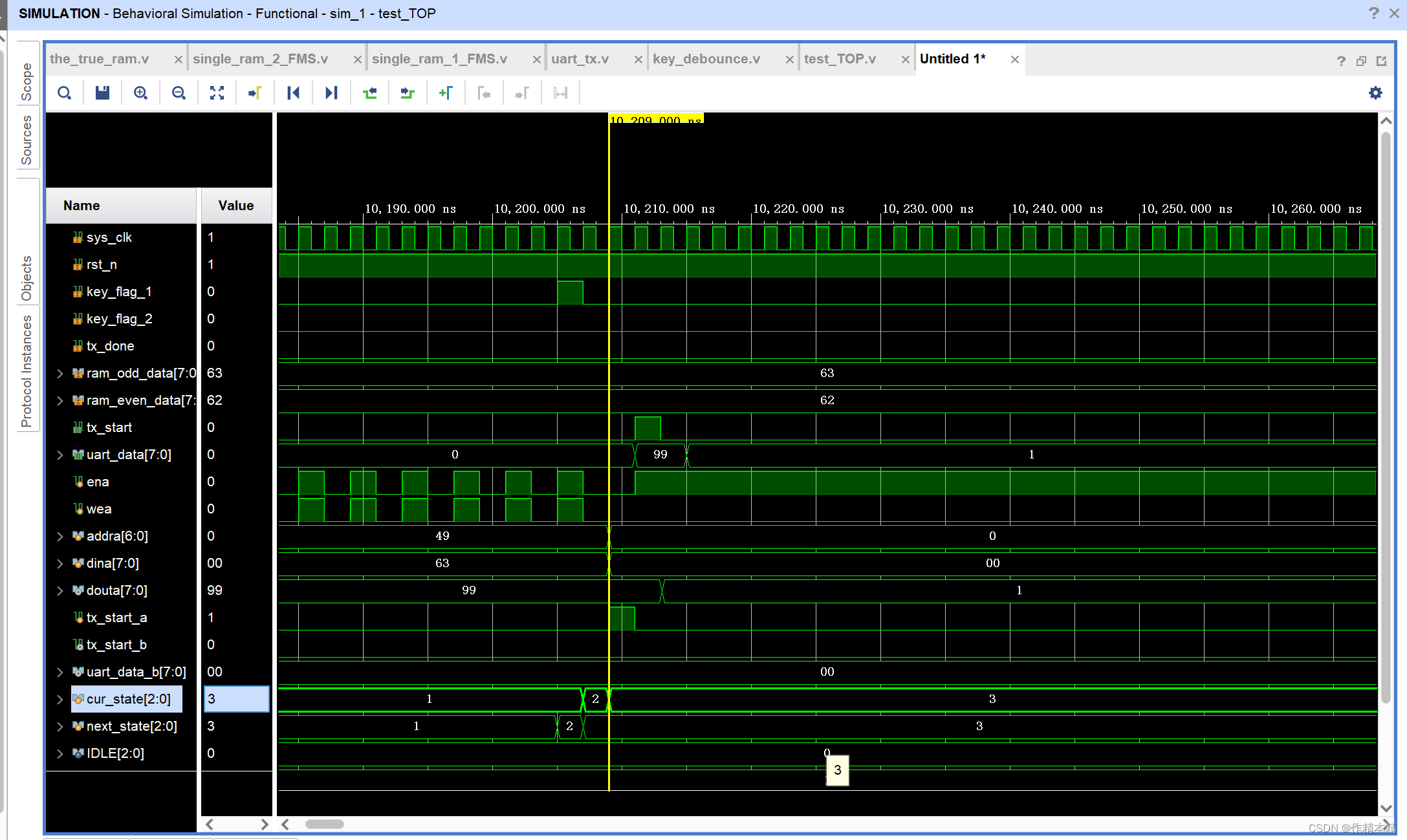
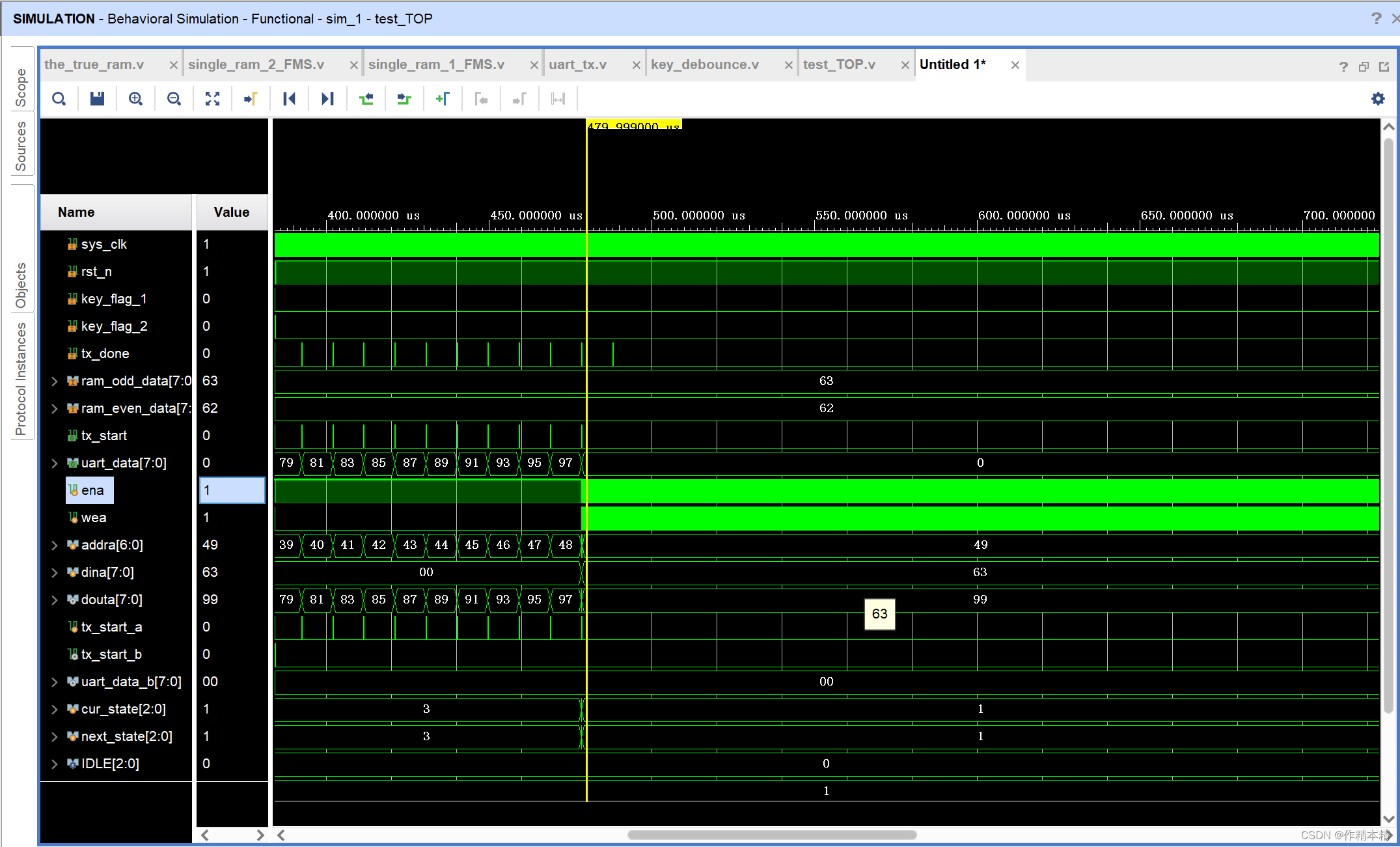
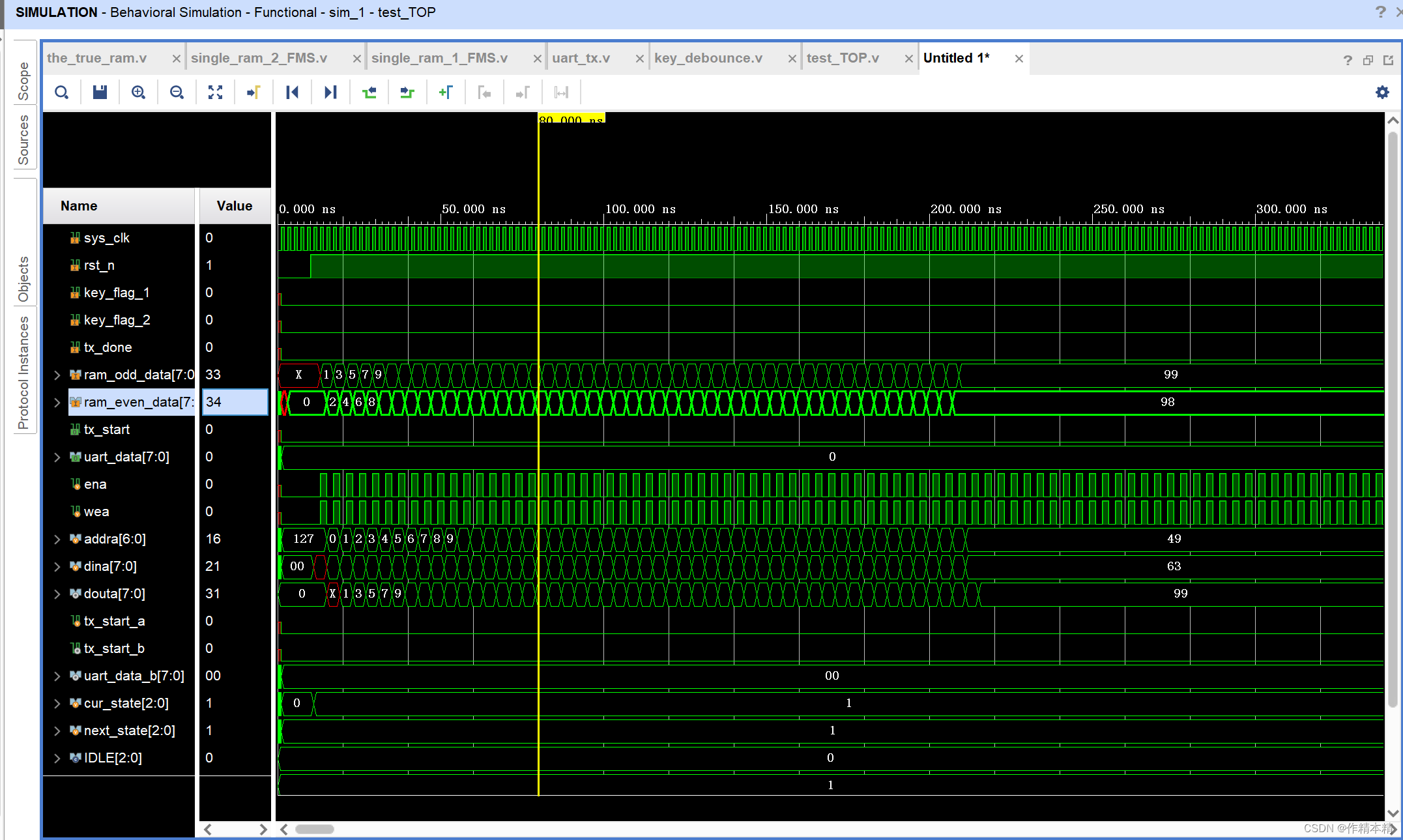
五、需要注意的一些问题
(1)
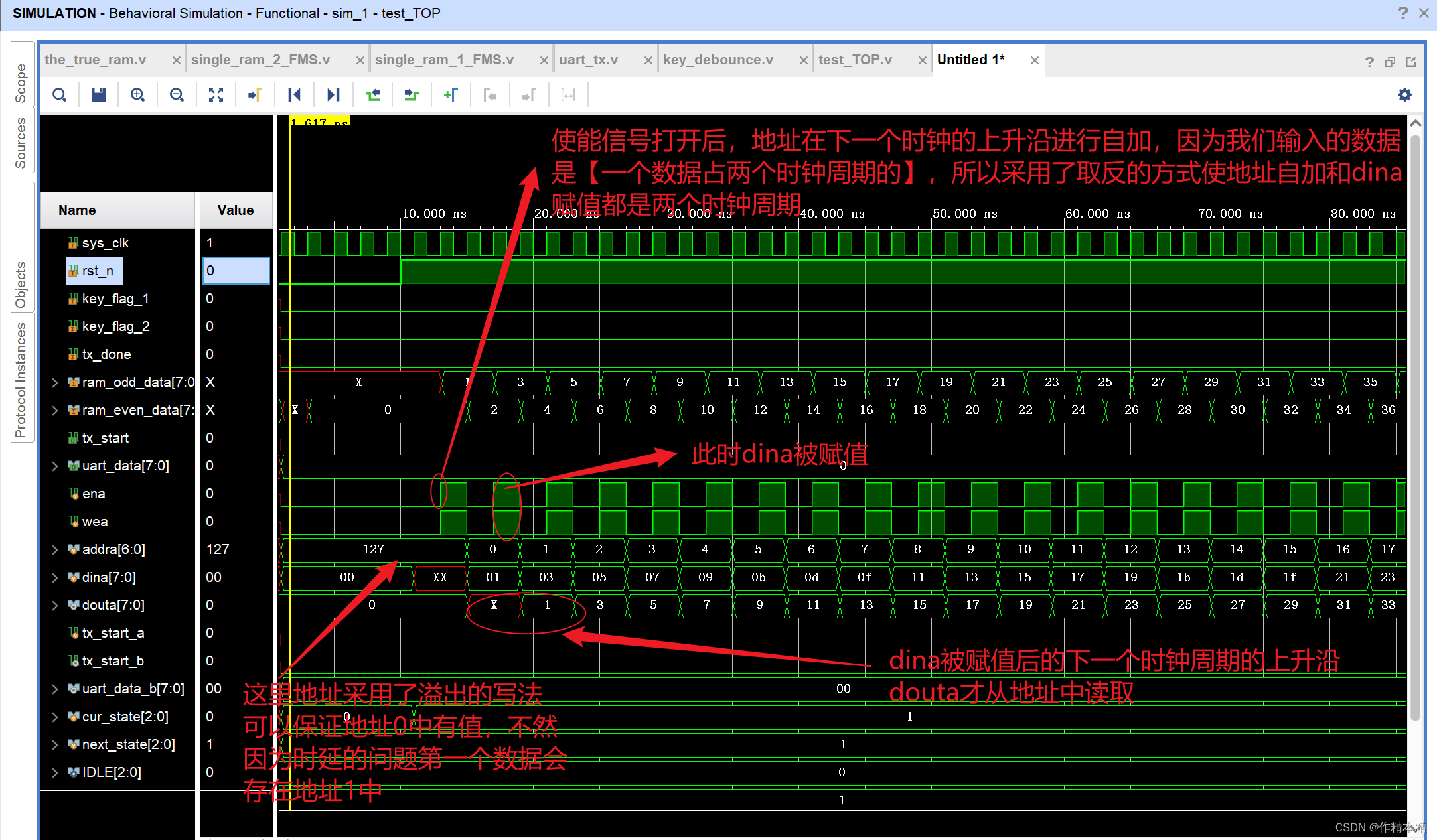
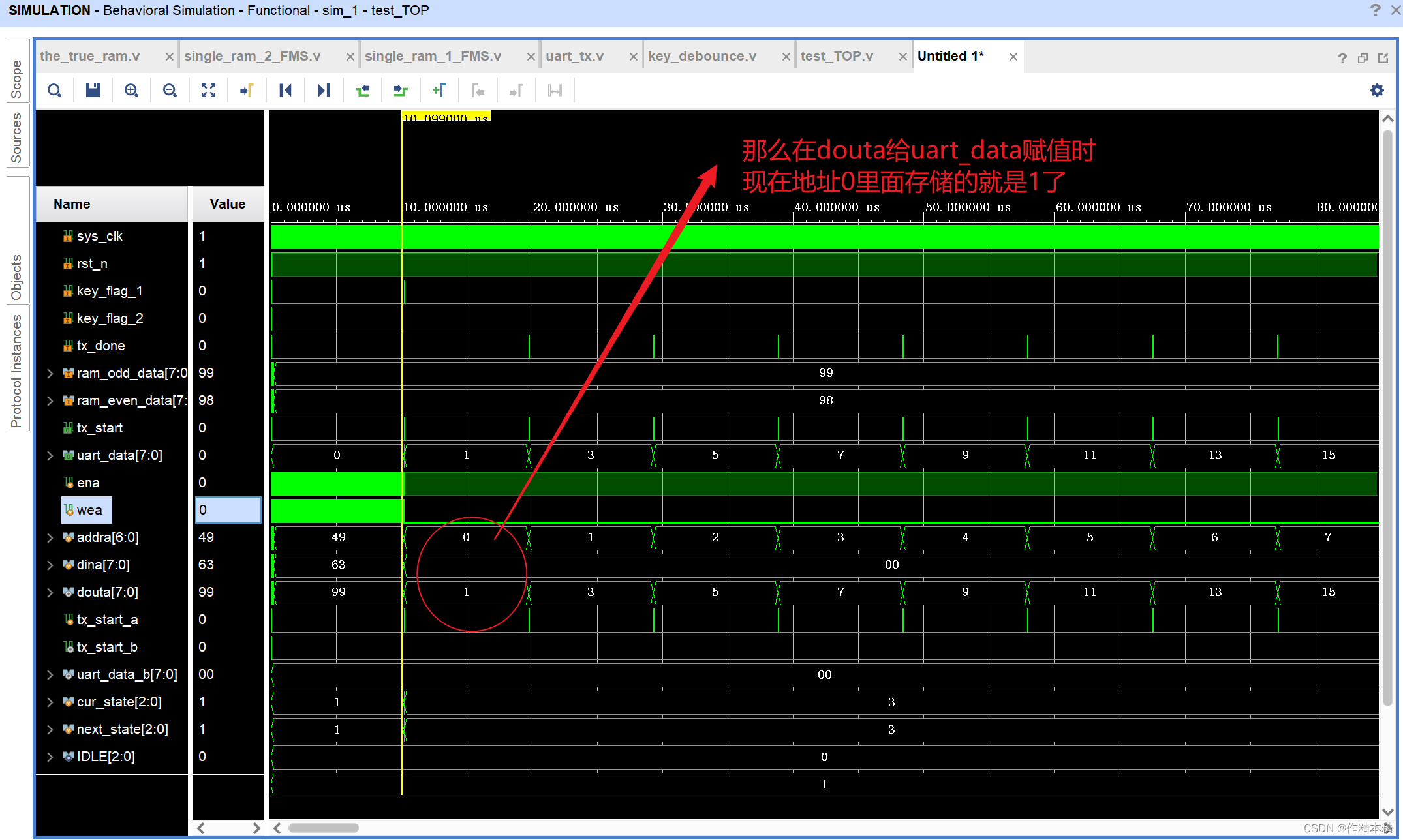
(2)

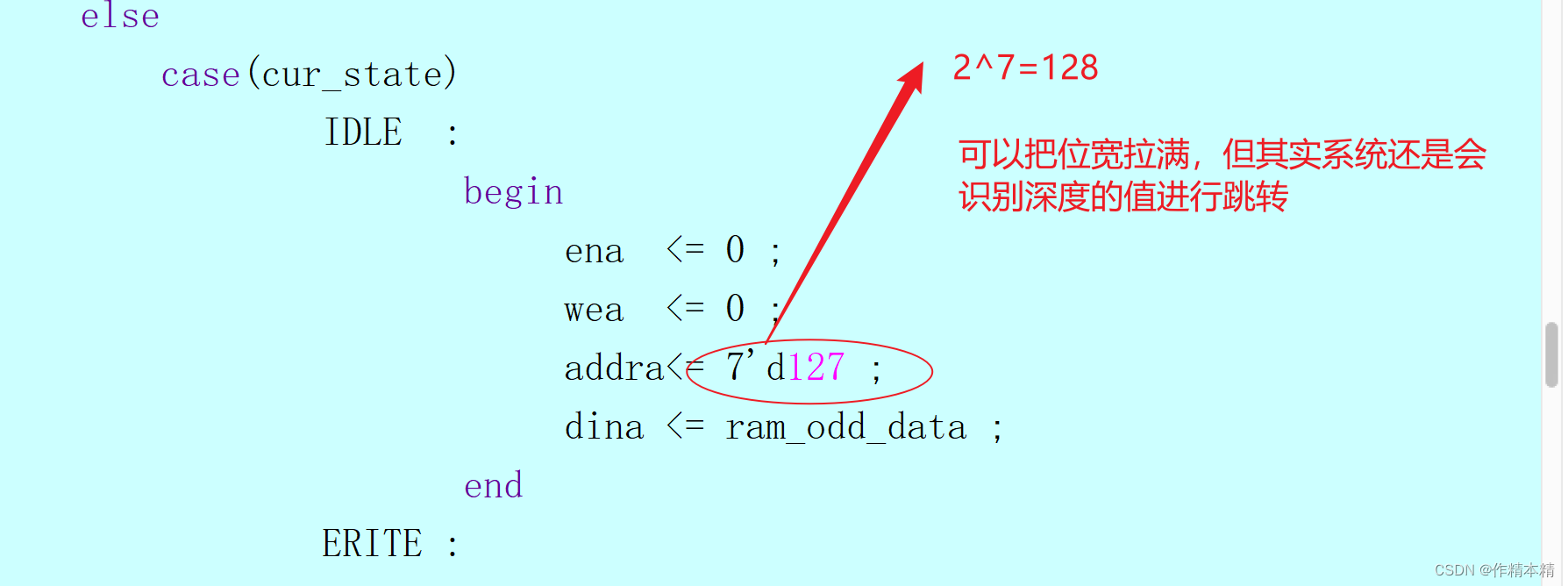
(3)控制模块最好这么写
`timescale 1ns / 1ps
module single_ram_2(
input sysclk ,
input rst_n ,
input key_flag1 ,
input key_flag2 ,
input tx_done ,
input [7:0] ram_odd_data , //单数
input [7:0] ram_even_data , //双数
output reg tx_start ,
output reg [7:0] uart_data
);
//存单数的RAM
reg wea ;
reg ena ;
reg [6:0] addra ;
reg [7:0] dina ;
wire [7:0] douta ;
///先写再读出
localparam IDLE = 3'd0;
localparam WRITE = 3'd1; 地址加1
localparam REG = 3'd2; ///缓冲状态 地址清零
localparam READ = 3'd3;
reg [2:0] cur_state,next_state;
reg tx_start_a ;
always@(posedge sysclk)
if(!rst_n)
cur_state <= IDLE;
else
cur_state <= next_state;
always@(*)
case(cur_state)
IDLE : begin
if(key_flag1)
next_state = WRITE;
else
next_state = cur_state;
end
WRITE :begin
if(addra >= 49)
next_state = REG;
else
next_state = cur_state;
end
REG :begin
next_state = READ;
end
READ :begin
if(addra >= 49)
next_state = IDLE;
else
next_state = cur_state;
end
default:;
endcase
always@(posedge sysclk)
if(!rst_n)begin
addra <= 0;
wea <= 0;
ena <= 0;
dina <= 0;
tx_start_a <= 0;
end
else
case(cur_state)
IDLE :begin
addra <= 0;
wea <= 0;
ena <= 0;
dina <= ram_odd_data; 维持2个
end
WRITE :begin ///99/48
ena <= ~ena; ///
wea <= ~wea; ///
if(addra >= 49)
addra <= 49;
else if(wea)
addra <= addra + 1;
dina <= ram_odd_data;
end
REG :begin
addra <= 0;
ena <= 0;
wea <= 0;
dina <= 0;
tx_start_a <= 1; ///发送第一个数据
end
READ :begin
ena <= 1;
wea <= 0;
dina <= 0;
if(tx_done)begin
tx_start_a <= 1;
addra <= addra + 1;
end
else begin
tx_start_a <= 0;
addra <= addra;
end
end
default:;
endcase
blk_mem_gen_2 ram_a (
.clka(sysclk), // input wire clka
.ena(ena), // input wire ena
.wea(wea), // input wire [0 : 0] wea
.addra(addra), // input wire [6 : 0] addra
.dina(dina), // input wire [7 : 0] dina
.douta(douta) // output wire [7 : 0] douta
);
/b端口 存双数
reg web ;
reg enb ;
reg [6:0] addrb ;
reg [7:0] dinb ;
wire [7:0] doutb;
//状态机
///先写再读出
localparam RD_IDLE = 3'd4;
localparam RD_WRITE = 3'd5;
localparam RD_REG = 3'd6; ///缓冲状态
localparam RD_READ = 3'd7;
reg [2:0] rd_cur_state,rd_next_state;
reg tx_start_b ;
always@(posedge sysclk)
if(!rst_n)
rd_cur_state <= RD_IDLE;
else
rd_cur_state <= rd_next_state;
always@(*)
case(rd_cur_state)
RD_IDLE : begin
if(key_flag2)
rd_next_state = RD_WRITE;
else
rd_next_state = rd_cur_state;
end
RD_WRITE :begin
if(addrb >= 49)
rd_next_state = RD_REG;
else
rd_next_state = rd_cur_state;
end
RD_REG :begin
rd_next_state = RD_READ;
end
RD_READ :begin
if(addrb >= 49)
rd_next_state = RD_IDLE;
else
rd_next_state = rd_cur_state;
end
default:;
endcase
always@(posedge sysclk)
if(!rst_n)begin
addrb <= 0;
web <= 0;
enb <= 0;
dinb <= 0;
tx_start_b <= 0;
end
else
case(rd_cur_state)
RD_IDLE :begin
addrb <= 0;
web <= 0;
enb <= 0;
dinb <= ram_even_data; ///020406
end
RD_WRITE :begin
enb <= ~enb;
web <= ~web;
if(addrb >= 49)
addrb <= 49;
else if(web)
addrb <= addrb + 1;
dinb <= ram_even_data;
end
RD_REG :begin
addrb <= 0;
enb <= 0;
web <= 0;
dinb <= 0;
tx_start_b <= 1;
end
RD_READ :begin
enb <= 1;
web <= 0;
dinb <= 0;
if(tx_done)begin
tx_start_b <= 1;
addrb <= addrb + 1;
end
else begin
tx_start_b <= 0;
addrb <= addrb;
end
end
default:;
endcase
blk_mem_gen_2 ram_b (
.clka(sysclk), // input wire clka
.ena(enb), // input wire ena
.wea(web), // input wire [0 : 0] wea
.addra(addrb), // input wire [6 : 0] addra
.dina(dinb), // input wire [7 : 0] dina
.douta(doutb) // output wire [7 : 0] douta
);
always@(posedge sysclk)
if(!rst_n)
uart_data <= 0;
else if(cur_state == READ )
uart_data <= douta ;
else if(rd_cur_state == RD_READ )
uart_data <= doutb ;
else
uart_data <= uart_data;
always@(posedge sysclk)
if(!rst_n)
tx_start <= 0;
else if(cur_state == REG || cur_state == READ)
tx_start <= tx_start_a;
else if(rd_cur_state == RD_REG || rd_cur_state == RD_READ)
tx_start <= tx_start_b;
else
tx_start <= tx_start;
endmodule











